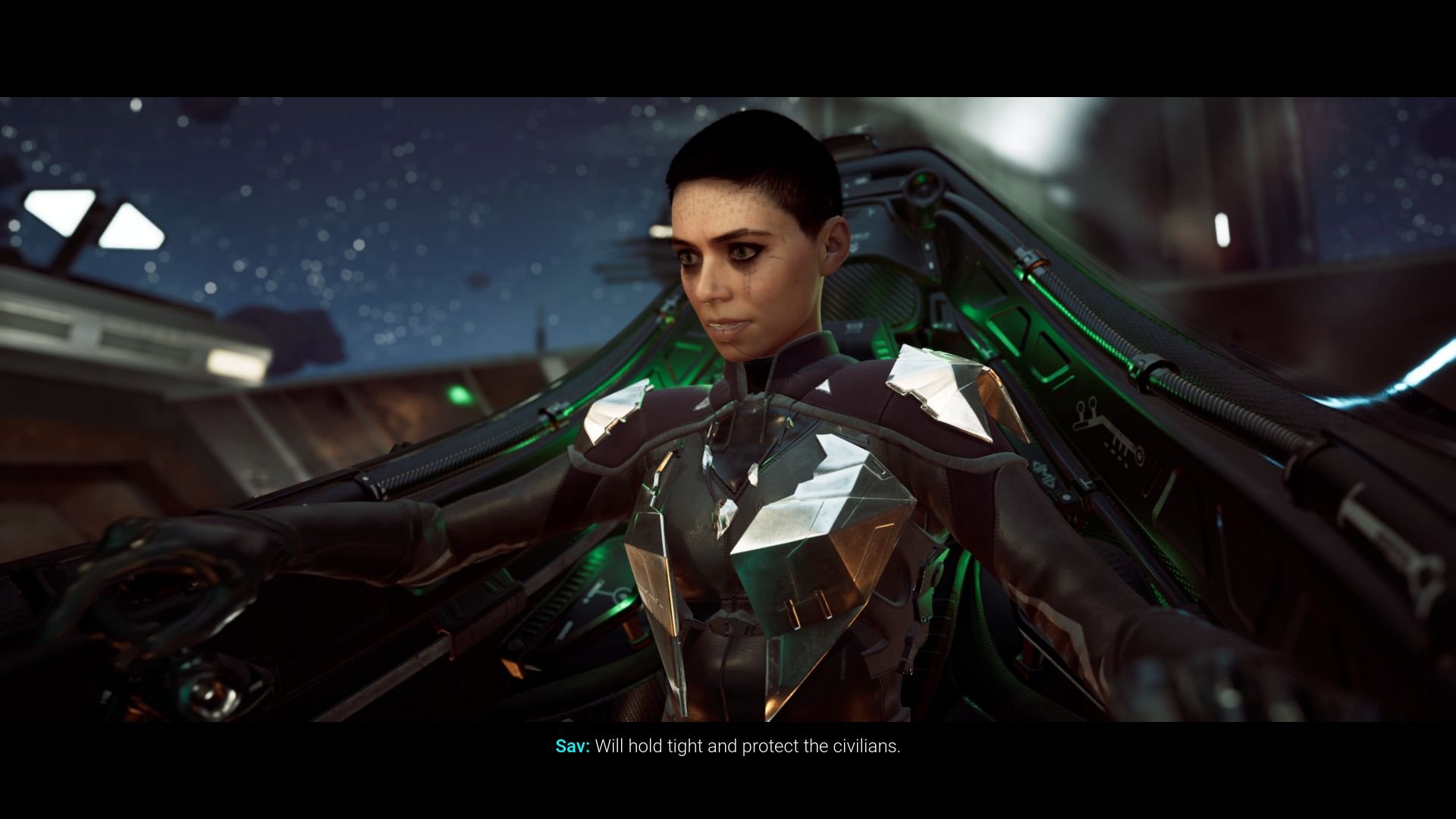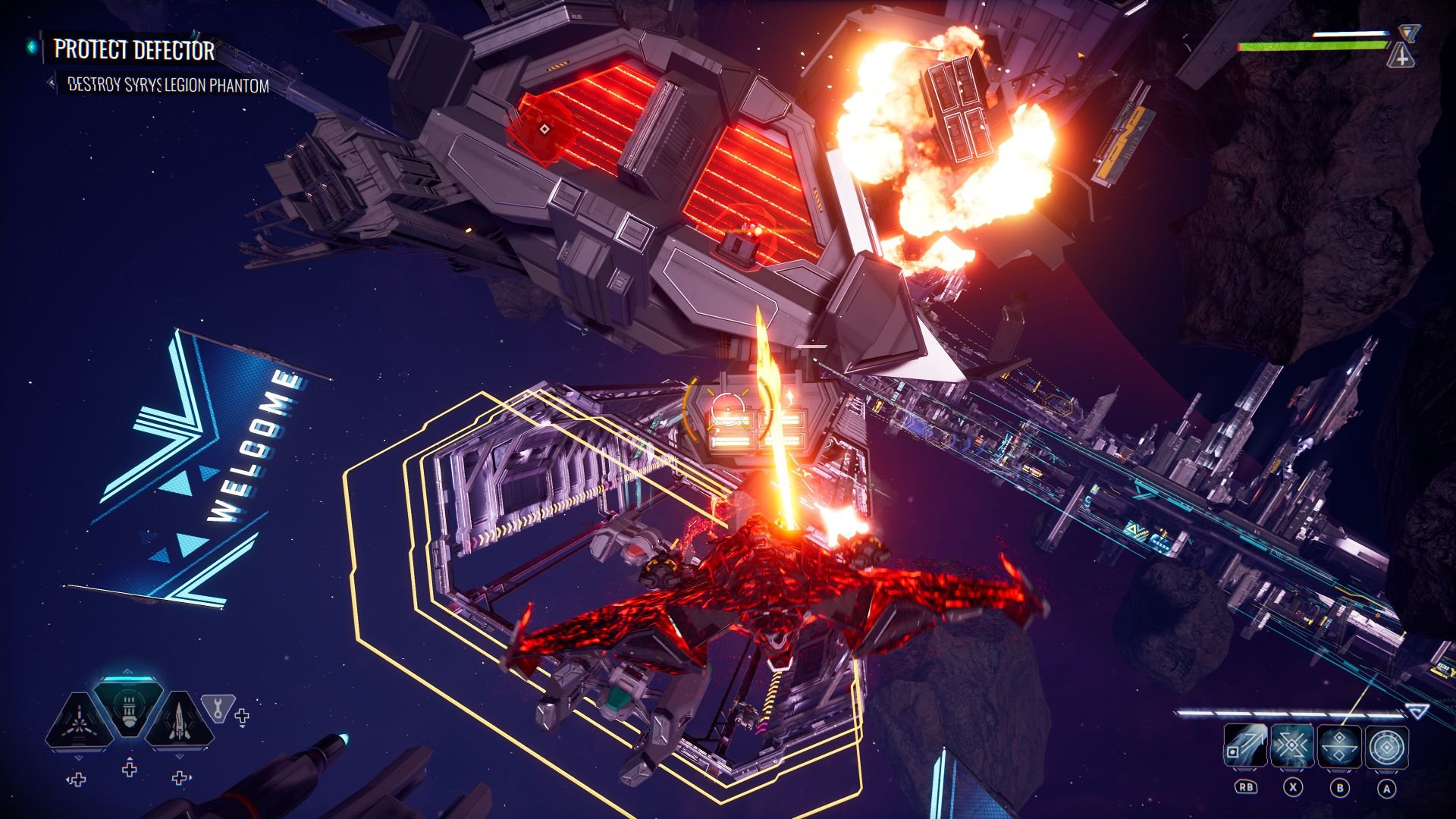We are Chorus
Developed by Galaxy on Fire developer, Fishlabs, Chorus was a game that I hadn’t gone around to playing until well after I had put together my Game of the Year list for 2021, and honestly, I regret not playing it sooner. Its breadth of action and story-telling is remarkably top-notch for a team normally known for the mobile market. While a few issues hold this game back from being a truly stellar experience, I still found myself hooked on its world, its protagonist, and the intense action at the forefront of its mobility-focused combat.
Chorus tells the story of Nara, an ex-disciple of a cult called The Circle, and responsible for the destruction of Namika Prime. Stricken with guilt over the atrocities she committed in their name, she flees to the far side of the galaxy, hoping to atone for her sins far away from her former Master. However; as the cult has focused itself back on Nimika Prime, Nara must work alongside her newfound allies in the resistance in an effort to stop a maniacal Prophet from taking over the galaxy.
While Nara is the central protagonist, she won’t be on this journey alone. Forsaken, her sentient fighter craft which is often named Forsa, is by her side, but there is some friction between the two as Nara hid Forsa for years while she went into hiding herself, subsequently abandoning him. Nara and Forsa following that reunion are not on the best of terms and this leads to some fantastic storytelling between the two. The major narrative beats are then built around the pair working as a team to take the Prophet down. While I won’t dive into the conclusion of the game, I was actually impressed with how everything wrapped up, especially what becomes of both Nara and Forsa, an end that felt both extremely fitting and earned.
Much of the story is told in a few different ways; either Nara has a conversation with an NPC via a static image in her viewscreen, a cutscene of Nara outside her ship, or Nara talking with Forsa about their mission and what is next. Nara will also reflect on certain moments via her thoughts, sometimes in the middle of a conversation, allowing you to know more about her as a person and the guilt she still feels built up in her. Lastly, and this is by far the most used for how it rolls out its narrative, is through flashbacks that are triggered when approaching some sort of memory echo in space. These events have a hologram-like aesthetic, and often reveal key moments of the past that are relevant to the present.
The main story of Nara working alongside her new allies, and even that of some old friends, works well when it’s happening in front of you. Some side quests don’t quite have the same writing quality to them or even adapt the lore properly. One such example is Nara aiding stranded ships with the sharing of fuel, complete with the sounds of fluids being funneled between the two. However; her ship should not even contain fuel due to its dark matter singularity engine. Another example of the game not playing to the rules of its own story is how no one seems to remember her or her ship destroying Nimika, especially when you are spending hours flying around it, aiding some of its civilians, or stopping in to get your ship and its weapons upgraded.
While Forsa is the main ship that Nara will pilot for much of the game, you’ll also get into a few other vessels from time to time. These are generally weapon-based ships that are mostly there to roll out significant damage and take a beating, it’s just a shame they don’t control well at all. I found these additional vessels to happen just far apart from one another that I would forget their controls and it’s a shame they don’t adapt to the same configuration as Forsa which makes them not fun to steer around, but are a riot when it comes to their weaponry.
Being a space shooter, you certainly need to have something solid in regards to your gameplay, especially if you craft a title that is somewhere around the 20-25 hour mark. The main story and its selection of side quests should take you about that long, at least if you don’t tire of a few side activities that can feel a bit too repetitive at times both in their gameplay and their repeated dialogue. Thankfully, apart from those additional vessels to pilot, Chorus is a joy to play regardless of the tasks and that is largely due to a few things that this game fully does right.
First off, Nara is a pilot that is gifted with special abilities that transfer into her ship being able to perform some remarkable feats. You’ll earn these back as Nara’s abandonment of the cult has left her rusty and she’ll need to revisit certain areas and moments to get an understanding of the power she once had. Each Rite is gained as you explore a series of puzzle-like temples that Nara will visit with Forsa, and each temple has its own history and is part of her past in a lot of ways, some even having character-driven cutscenes devoted to them. And, in typical fashion, you’ll earn these abilities in a temple that is designed around teaching you how to use them and to convey that use into the rest of its gameplay.
These Rites allow Nara to do some pretty amazing things and these can often set Chorus apart from several games in the genre. From teleporting behind enemy ships to boosting right through them, not to mention being able to turn on a dime with some well-handled drifting, these abilities can often lead to some intensely fast-paced encounters that require you to pull them off without a hitch, taking down multiple enemies, squadrons, and even some fantastical boss encounters that truly test your skills.
While the Rites certainly do make combat exciting due to their combo potential, shooting and maneuvering feel incredibly solid and the feel of moving your ship around is sublime. While I do wish I could tilt left and right to maybe fly in between narrow vertical gaps, I was constantly impressed with just how great it felt to fly around and tear through enemies. You can outfit your ship with a standard machine gun, as well as lasers and missiles, but within those guns, there isn’t too much variety apart from a few guns that simply have a different fire rate or other stat changes. You do have some modifications to add as well, but these largely play into whatever makes the number go up in the category you want.
You’ll change most of your modifications, or buy new ones, as well as items used to boost your shields, at various hangers, but oddly, they are so visually hard to find since they don’t seem to have an icon on the map or show up when I use a pulse vision that Nara has. I often would fly back to the first area to use the hanger there since I knew where it was. Nara’s pulse vision also could have stood to allow it to hold on to locations and items it pings a bit longer than it does, as you’ll constantly be using it over and over again to ping the locations of new quests and items around you.
Nara, and subsequently, Forsa, will have a few different speeds to burn through space as well as a dodge roll that comes in handy during encounters. While the standard speed is fine for dogfighting and flying in between various space stations and structures, there are times where the faster burn isn’t available and since some travel is across great distances, there is a weird pacing to some of its traversal. This doesn’t happen that often, but when it does, it is very noticeable.
When you take in the fantastic flying controls and all Nara’s Rites, you’ll put them to use against space pirates and most notably, The Circle. There isn’t a vast range of different ships, but there is enough variety in what they can do to keep combat exciting. There are also the big cruiser vessels that usually have you flying in and around them, shooting at exposed power cores or other means to destroy them that can feel a bit too easy at times, but are still thrilling encounters regardless of their simplicity. Flying in one end, blasting the core, and escaping the other after an explosion never lost its thrill.
Despite some shortcuts that clearly indicate this game had a very tight budget, Chorus is a damn good-looking game and certainly gets the most out of its budget. The character model and voice work for Nara are both equally fantastic as do the various ships and environments, which grant an impressive series of dramatically different locales despite the entire game taking place in space. From a huge space station to a frozen emptiness of ice formations, I was consistently impressed with what this team was able to deliver on and never tired of just exploring, tracking down all the collectibles, side quests, or the special objectives you have that grant you various perks and stat increases as you complete a series of various tasks such as killing enemies after a leap or spearing through dozens of enemies. In fact, just playing the game allowed me to unlock a great deal of them without having them as any sort of distracted focus.
While I’ve clearly been critical about some of Chorus’ failings, don’t get me wrong, I had an amazing time here. The final act of the game is downright impressive with a few boss fights that were so good that I wish there were more. In fact, I wish there was more of pretty much everything. The shooting consistently felt great, and the Rites were incredibly fun to use, making each combat encounter so much fun that I was actively flying around trying to find some random encounters. While we are not starving for various space shooters, Chorus is certainly one of the best available and a game that has put the developer on my watch list.
Developer - Fishlabs, Deep Silver, Deep Silver Dambuster Studios. Publisher - Deep Silver, Koch Media. Released - December 3rd, 2021. Available On - Xbox One, Xbox Series S/X, PS4, PS5, Windows, Stadia, Amazon Luna. Rated - (T) Fantasy Violence, Mild Language.
Platform Reviewed - Xbox Series X. Review Access - Chorus was purchased by the reviewer.















